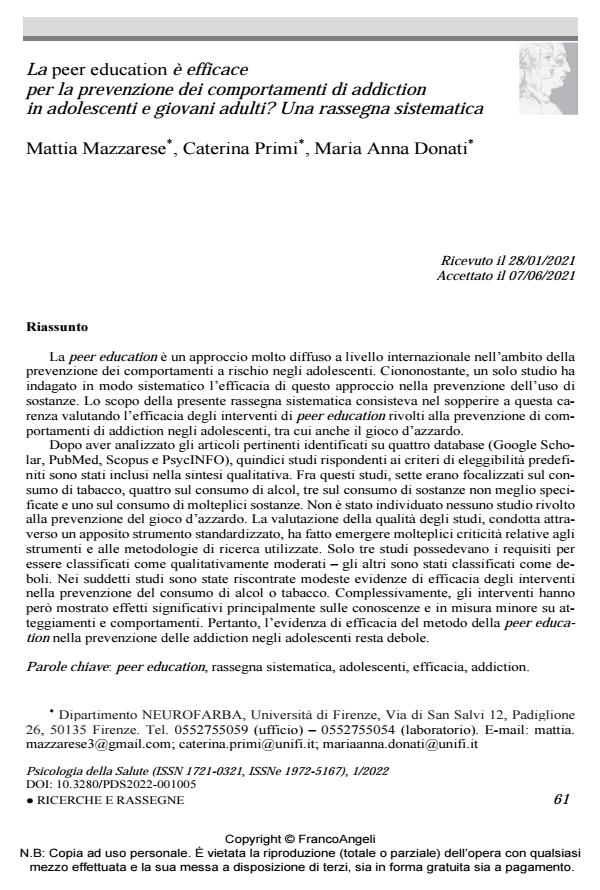La peer education è efficace per la prevenzione dei comportamenti di addiction in adolescenti e giovani adulti? Una rassegna sistematica
Titolo Rivista PSICOLOGIA DELLA SALUTE
Autori/Curatori Mattia Mazzarese, Caterina Primi, Maria Anna Donati
Anno di pubblicazione 2022 Fascicolo 2022/1
Lingua Italiano Numero pagine 30 P. 61-90 Dimensione file 325 KB
DOI 10.3280/PDS2022-001005
Il DOI è il codice a barre della proprietà intellettuale: per saperne di più
clicca qui
Qui sotto puoi vedere in anteprima la prima pagina di questo articolo.
Se questo articolo ti interessa, lo puoi acquistare (e scaricare in formato pdf) seguendo le facili indicazioni per acquistare il download credit. Acquista Download Credits per scaricare questo Articolo in formato PDF

FrancoAngeli è membro della Publishers International Linking Association, Inc (PILA)associazione indipendente e non profit per facilitare (attraverso i servizi tecnologici implementati da CrossRef.org) l’accesso degli studiosi ai contenuti digitali nelle pubblicazioni professionali e scientifiche
La peer education è un approccio molto diffuso a livello internazionale nell’ambito della prevenzione dei comportamenti a rischio negli adolescenti. Ciononostante, un solo studio ha indagato in modo sistematico l’efficacia di questo approccio nella prevenzione dell’uso di so-stanze. Lo scopo della presente rassegna sistematica consisteva nel sopperire a questa carenza valutando l’efficacia degli interventi di peer education rivolti alla prevenzione di comportamenti di addiction negli adolescenti, tra cui anche il gioco d’azzardo. Dopo aver analizzato gli articoli pertinenti identificati su quattro database (Google Scholar, PubMed, Scopus e PsycINFO), quindici studi rispondenti ai criteri di eleggibilità predefiniti sono stati inclusi nella sintesi qualitativa. Fra questi studi, sette erano focalizzati sul consumo di tabacco, quattro sul consumo di alcol, tre sul consumo di sostanze non meglio specificate e uno sul consumo di molteplici sostanze. Non è stato individuato nessuno studio rivolto alla prevenzione del gioco d’azzardo. La valutazione della qualità degli studi, condotta attraverso un apposito strumento standardizzato, ha fatto emergere molteplici criticità relative agli strumenti e alle metodologie di ricerca utilizzate. Solo tre studi possedevano i requisiti per essere classificati come qualitativamente moderati - gli altri sono stati classificati come deboli. Nei suddetti studi sono state riscontrate modeste evidenze di efficacia degli interventi nella preven-zione del consumo di alcol o tabacco. Complessivamente, gli interventi hanno però mostrato effetti significativi principalmente sulle conoscenze e in misura minore su atteggiamenti e com-portamenti. Pertanto, l’evidenza di efficacia del metodo della peer education nella prevenzione delle addiction negli adolescenti resta debole.
Parole chiave:peer education, rassegna sistematica, adolescenti, efficacia, addiction.
Mattia Mazzarese, Caterina Primi, Maria Anna Donati, La peer education è efficace per la prevenzione dei comportamenti di addiction in adolescenti e giovani adulti? Una rassegna sistematica in "PSICOLOGIA DELLA SALUTE" 1/2022, pp 61-90, DOI: 10.3280/PDS2022-001005